The following is a copy of a thread I posted on thegolfforum.com some time ago with the intention of posting here once Michael Taylor had done a few of his New Zealand course reviews. Somehow, it didn’t make its way here but on the request of a few of our New Zealand friends, I will try to get it all up here over the next few days.
The 2012 GCA Boomerang was staged at Paraparaumu Beach which, until the last decade, was widely regarded as New Zealand's No.1 track. It's located on the Kapiti Coast about 45 minutes north west of Wellington. The locals say it has a micro-climate as due to Kapiti Island sitting just off shore. I can't say we saw the benefit of that micro-climate while we were there.
I made the trip not knowing too much about the place other than it was a links course designed by Alex Russell, the NZ Open was last played there in 2002 when Tiger Woods commanded an appearance fee of $4m and only just made the cut, and that there had been some criticism a few years back of the soft greens.
In looking at the aerial photo on Google Maps prior to my departure, the first thing which struck me was the size of the property. It's not very big. However, it makes great use of the land it's located upon.
The property is split into three portions by ridges of dunes. There's a large ridge "separating" holes 5-9 from the rest of the course and a smaller ridge separating 10, 11 and 12. the remainder of the holes play across the middle portion of the course. The course is an exercise in good routing. Russell was presented with a small piece of land and the abovementioned dunal ridges, yet has created a course which flows well and makes full use of what lies in between without the need to implement many man-made hazards. In his favour was that the land is pure linksland with some excellent natural landforms which provide the basis for excellent green sites. His ability to utilise those sites on such a small property is testament to his ability as an architect.
Not all the credit remains with Russell. Prior to his redesign of the course in 1949, there was a layout which had existed since the early 1930s. Many of the holes today play over the same routing as the original layout. Russell did, however, make a number of key changes and gave us the sublime 16th hole.
I'd read on GCA that mushy poa greens has ruined the playability of the course. Happily, I can report that is no longer the case. The greens were some of the best surfaces I've encountered for a while (especially given the downpour the previous afternoon), and firm, which is a vital ingredient in the playability of any links course.
Anyway, onto my pics. I was a bit restricted by the murky weather but Leo Barber will no doubt add some of his own magnificent photos.
1st hole - 368m Par 4The first is a generous opener but no pushover. It's a gentle dogleg left with plenty of room to land the drive. The bold line is to take your drive close to the dune on the left to shorten the approach but this may leave you with a blind second shot. The green is bunkerless but drops off on the right.



View from the second tee:
 2nd hole - 185m Par 3
2nd hole - 185m Par 3This is a long par three which plays back into the prevailing breeze. The rolling land between the tee and green is a sign of things to come. The front bunker shouldn't worry the better players. The green sits atop a dune and a miss left or right will leave you 6 feet below the putting surface. There's a really cool landing zone short of the green allowing you to run a shot in. The green has some deceptive breaks. You should be happy to walk off here with a 3.


Second green (and fourth green) from the third tee:

The third and fourth holes play side-by-side in opposite directions and complement each other nicely. They are both long par fours.
3rd hole - 390m Par 4The 3rd is 383m from the blue tees and usually plays into the wind so, although it is shorter than its companion, it tends to play longer. There is generous room to drive as the third and fourth holes share some common fairway. If one is long enough, he/she must avoid the dune on the right. Longer drives will find the upslope of the fairway which inhibits the golfer obtaining maximum distance from the tee. The locals appeared to favour driving out to the right as the percentage play, well away from the grassy dunes which border the left side of the fairway. From the right the shot is semi-blind thanks to the right side dune but the angle opens up the green. The second shot is played to a large green which slopes from front right to back left. There are three traps guarding the left side. Anything long will be down the slope presenting a tough chip back.




 4th hole - 408m Par 4
4th hole - 408m Par 4Longer than its predecessor, but tends to play a touch shorter. Just like the last hole there is adequate room to bail right, but that creates the worst angle to the green. Along the left is a high ridge of dunes. Finding oneself on these in the long grass is a recipe for a big number, but the player who wants to create the best angle to the green needs to flirt with the left side. There is also a bit of a fast lane as your balls can kick off the firmer ridges that run off the dunes. The long green is angled left to right and is protected on the right by three pots. Another trap is middle-left nestled in against a large sand dune. A classic links par four.



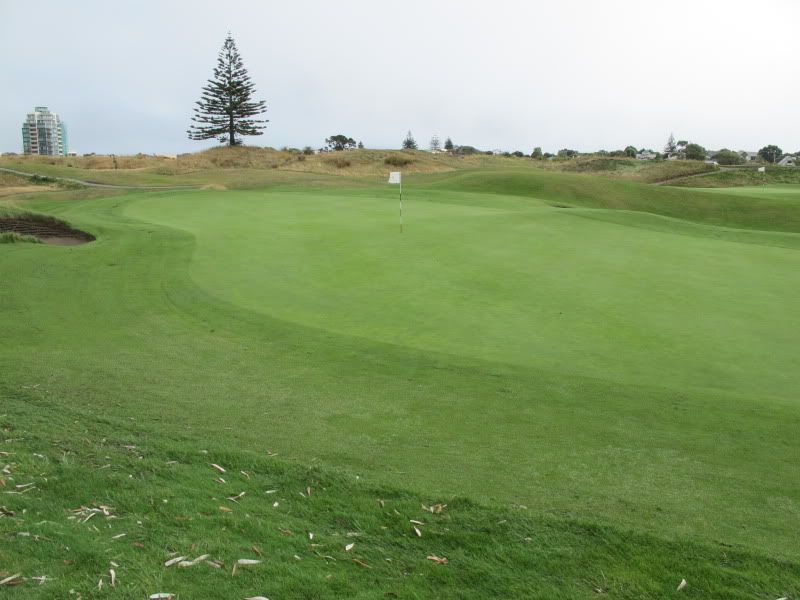
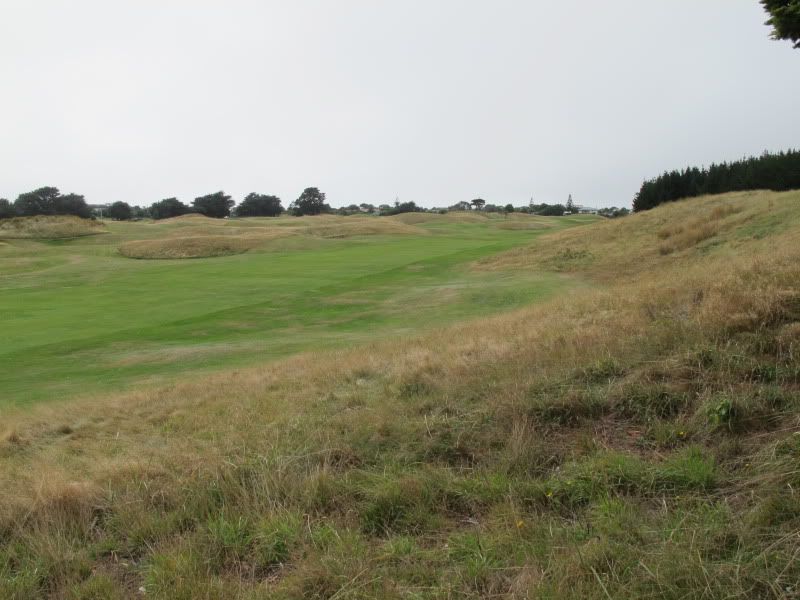

The 5th and 6th holes are the cornerstone of the routing here. In order to make use of the narrow strip of land south east of the ridge and return the 9 to the clubhouse, the architect (it appears the original architects – not Russell) had to fit in two holes running the opposite direction.
5th hole - 150m Par 3 The fifth is a fantastic par three. It's a mid iron to a plateau green which sits atop a dune. The green drops away on every side bar the back left portion. In effect, it's an island green without water. Missing the green on the wrong side is deadly, although the putting surface is amply large to allow some chance of recovering par. When we played it the banks were soft and the fringes a bit fluffy. Playing in the middle of summer with tight lies from off the green would make recovery a more fearsome proposition. Leo told us the story of Frank Nobilo destroying his chances in a New Zealand Open when he played some army golf to take a 7.
Russell's original design was for the tee to sit high up on the dune left of the current tee. At one stage during the Boomerang we went up there for a look. It would make for a spectacular drop shot but I'm of the view that the present tee is likely to play better (even if less spectacular).

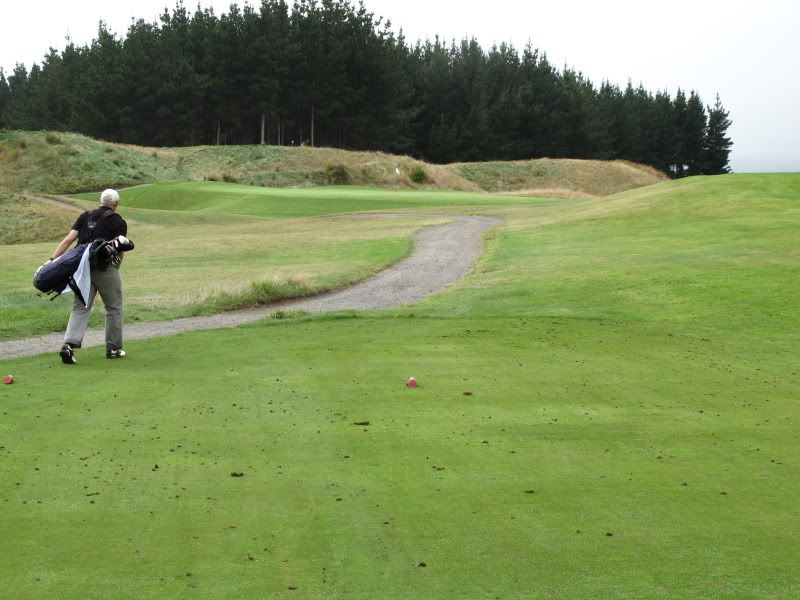


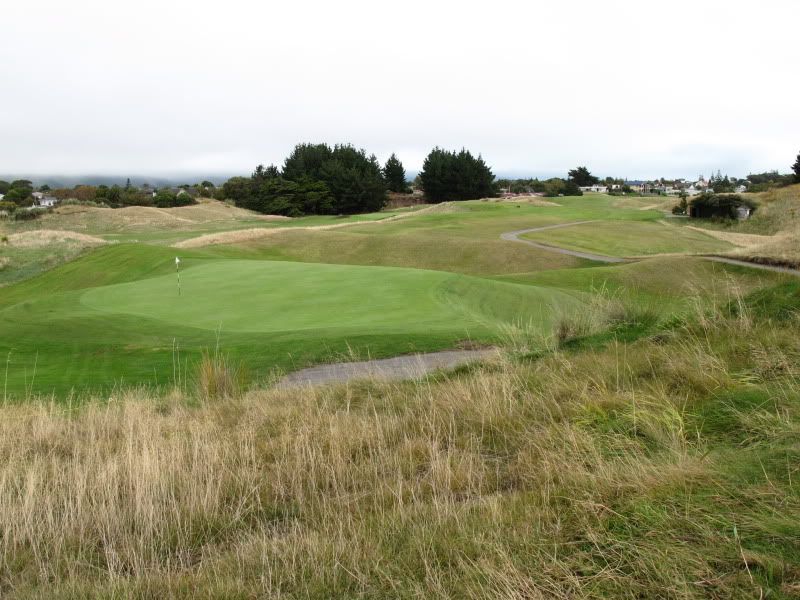 6th hole - 286m Par 4
6th hole - 286m Par 4 The 6th is a driveable par 4. It plays from an elevated tee into the eastern corner of the golf course which it shares with the 14th green, 15th tee and 7th tee. The fairways contains some fantastic humps and hollows. At 286 metres it is not as easy as it looks. The green is narrow and tiered. There are traps both right and left (and another back right). If one attempts to drive the green and misses, he/she is left with a devilish approach which will struggle to hold the firm putting surface.
Laying up is not straightforward either. The heaving fairway will suck up your ball and spit it out. Most drives seemed to end up to the right of where they were struck so if the wind is up you may have to aim towards the dunes on the left to give yourself a good angle of approach. Both days we played to a pin on the lower tier. The locals told us it was a more difficult proposition when the pin is back, as it is almost impossible to hold a pitch on the back portion of the green which is a small target well protected either side by traps.
For some reason I didn't get a photo from the tee, but Leo has a special shot which I'm sure he will post.
Approach from the right hand side:

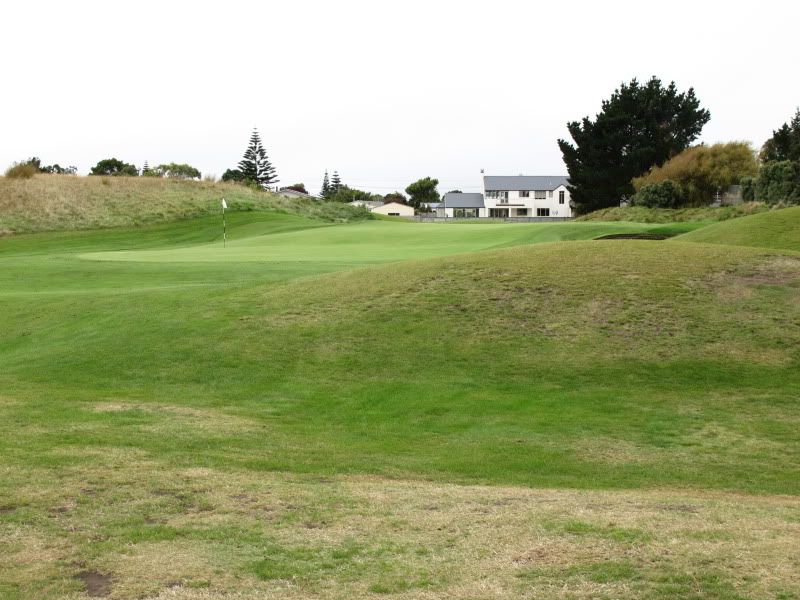
From back RHS of the green:
